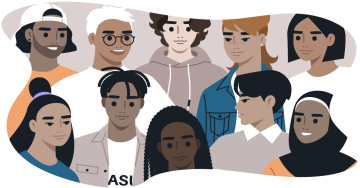A new generation is coming of age. Generation Z (or Gen Z) is taking the world by storm. As an association looking to grow membership, what will it take to attract and engage them? How are they different from their predecessors? And what impact does this have on your organization’s value proposition?
When analyzing Gen Z, it’s important to limit comparisons to other generations at the time they were young adults. Because youth itself can drive behaviors and preferences. Once you account for this, it’s clear that Gen Z is different from young adults that have come before them because the world has changed.
Gen Z has grown up against the backdrop of 24/7 access to information, mass shootings, economic instability, climate change, and a global pandemic. What effect are these events having on their needs and preferences? We’ve put together this snapshot of common characteristics, and how associations can respond.
Who is Gen Z?
- Born between 1997-2012
- Currently 20% of the U.S. population
- Projected to comprise 30% of the U.S. workforce by 2030
Here are five things every association needs to know about Gen Z
They are the most racially and ethnically diverse generation
Today 52% of Gen Z identifies as White vs. 61% of Millennials. And they are projected to be the last generation that will be predominantly white.
What does this mean for associations? If you haven’t already started integrating DE&I strategies into the fabric of your organization, now is the time to start. And don’t forget about neurodiversity too.
Gen Z has very different social media habits
If you’re looking to reach Gen Z, it’s time to expand your social media strategy beyond LinkedIn, “X” (formerly Twitter), and Facebook. 50% of young professionals today look to TikTok or Instagram instead of Google for answers. And 68% state that YouTube has helped them improve or gain skills.
Associations need to use these channels to provide proof of value. Share previews of programs, educational content, and member benefits. Especially as you compete against so many other free or low-cost online resources for information, education, and peer connections.
Mental health is a pervasive challenge
99% of Gen Z report they have experienced a mental health concern, and more than 50% are being treated for anxiety and depression (more than any other generation).
As a group, Gen Z is much more focused on mental health awareness and are more willing to openly discuss their challenges. As the voice of your industry, is there an opportunity for your association to provide greater advocacy for self-care and wellness, flexibility, and industry-specific mental health programs as a member benefit?
They pay attention to social causes
70% of Gen Zs consider themselves “involved” in a social or political cause. And just 20% say they would work for a company that doesn’t share their values.
As a mission-driven organization, associations have an extremely compelling story to tell. But it’s important to explicitly connect the dots between your organization’s work and how their individual membership contributes to this impact. And then, of course, tell this story using the channels that are most likely to reach them.
Economic stability is a major priority
During the pandemic, Gen Z saw firsthand just how fragile our economic system can be. They have also been watching their Millennial family members and friends struggle to purchase a home or pay off student debt. As a result, 74% of graduating college seniors surveyed say they’re prioritizing job stability during their employment search. And 42% admit to having a side-hustle to make ends meet.
Some of the greatest benefits of association membership are the professional development opportunities—from continuing education to networking. But don’t assume Gen Z understands this. With so many resources available at their fingertips, it’s important for associations to make a clear and compelling case for how their programs help them achieve financial growth and stability.
Associations already offer programs and opportunities that align with Gen Z’s needs and preferences. But with so many other resources competing for their attention, it will be important to make these connections for them through clear and compelling storytelling, in the right channels, while continuing to develop additional programs that help them achieve their goals.
For more ideas and insight on how to attract and engage Gen Z, watch this on-demand webinar: Spilling the Tea on Gen Z as Your Future Members and Employees.




Share The Love!